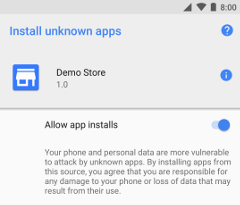يوفّر Android العديد من الخيارات، لأنّه نظام أساسي مفتوح. يمكنك توزيع تطبيقات Android على المستخدمين بأي طريقة تريدها، باستخدام أي نهج توزيع أو مزيج من الأساليب التي تلبي احتياجاتك. لن تكون محبطًا أبدًا في أي نظام أساسي لتوزيع التطبيقات، بدءًا من النشر في سوق التطبيقات إلى عرض التطبيقات من موقع إلكتروني أو إرسالها بالبريد الإلكتروني مباشرةً إلى المستخدمين.
عملية إنشاء التطبيقات ووضعها في حزم للتوزيع هي نفسها، بغض النظر عن طريقة توزيعها. يوفر لك هذا الوقت ويتيح لك أتمتة أجزاء من العملية حسب الحاجة. يمكنك الاطّلاع على صفحة الاستعداد للإصدار للحصول على مزيد من المعلومات.
تبرز الأقسام أدناه بعض البدائل لتوزيع تطبيقاتك.
التوزيع من خلال سوق التطبيقات
عادةً، للوصول إلى أوسع نطاق ممكن من الجمهور، يتم توزيع تطبيقاتك من خلال أحد الأسواق، مثل Google Play.
Google Play هو السوق الأول لتطبيقات Android، وهو مفيد بشكل خاص إذا كنت ترغب في توزيع تطبيقاتك على جمهور عالمي كبير. ومع ذلك، يمكنك توزيع تطبيقاتك من خلال أي سوق تطبيقات تريده أو استخدام أسواق متعددة.
على عكس أشكال التوزيع الأخرى، يسمح لك Google Play باستخدام خدمة الفوترة والترخيص داخل التطبيق. وتسهِّل خدمة الفوترة داخل التطبيقات بيع المنتجات داخل التطبيقات مثل جواهر الألعاب أو ترقيات ميزات التطبيقات. تساعد خدمة الترخيص في منع تثبيت تطبيقاتك واستخدامها بشكل غير مصرَّح به.
توزيع تطبيقاتك عبر البريد الإلكتروني
إحدى الطرق السريعة والسهلة لإصدار تطبيقاتك هي إرسالها إلى المستخدمين عبر البريد الإلكتروني. للقيام بذلك، تقوم بإعداد التطبيق للإصدار، وإرفاقه برسالة بريد إلكتروني، وإرساله إلى أحد المستخدمين. عندما يفتح المستخدم رسالتك الإلكترونية على جهازه الذي يعمل بنظام التشغيل Android، يتعرّف نظام Android على حزمة APK ويعرض زر التثبيت الآن في الرسالة الإلكترونية. يمكن للمستخدمين تثبيت تطبيقك عن طريق لمس الزر. يحتاج المستخدمون إلى تفعيل ميزة تثبيت التطبيقات غير المعروفة إذا لم يسبق لهم تفعيل هذه الميزة.
يكون توزيع التطبيقات عبر البريد الإلكتروني أمرًا سهلاً إذا كنت تريد إرسالها إلى عدد قليل من المستخدمين الموثوق بهم، لأنّ ذلك يوفّر إجراءات حماية قليلة من القرصنة والتوزيع غير المصرَّح به. بمعنى آخر، يمكن لأي شخص ترسل إليه تطبيقاتك إعادة توجيهها إلى الآخرين.
التوزيع من خلال موقع إلكتروني
إذا كنت لا ترغب في إصدار تطبيقاتك من أحد الأسواق مثل Google Play، يمكنك إتاحتها للتنزيل على موقعك الإلكتروني أو الخادم، بما في ذلك خادم خاص أو خادم مؤسسة. للقيام بذلك، عليك أولاً إعداد تطبيقاتك للإصدار بالطريقة العادية، ثم استضافة ملفات APK الجاهزة للإصدار على موقعك الإلكتروني وتزويد المستخدمين برابط تنزيل. لتثبيت تطبيق تم توزيعه بهذه الطريقة، على المستخدمين الموافقة على تثبيت التطبيقات غير المعروفة.
يوافق المستخدم على تثبيت التطبيقات غير المعروفة
يحمي Android المستخدمين من تنزيل وتثبيت التطبيقات غير المعروفة بدون قصد، أو التطبيقات من مصادر أخرى غير Google Play الموثوق بها. يحظر Android عمليات التثبيت هذه إلى أن يوافق المستخدم على السماح بتثبيت التطبيقات من مصادر أخرى. تعتمد عملية الموافقة على إصدار Android الذي يعمل على جهاز المستخدم:

الشكل 1: شاشة إعدادات النظام تثبيت تطبيقات غير معروفة، حيث يمنح المستخدمون الإذن لمصدر معيّن لتثبيت تطبيقات غير معروفة.
- على الأجهزة التي تعمل بنظام التشغيل Android 8.0 (المستوى 26 لواجهة برمجة التطبيقات) والإصدارات الأحدث، على المستخدمين الانتقال إلى شاشة إعدادات النظام تثبيت التطبيقات غير المعروفة لتفعيل عمليات تثبيت التطبيقات من موقع معيّن، كما هو موضّح في الشكل 1.
- على الأجهزة التي تعمل بنظام التشغيل Android 7.1.1 (المستوى 25 لواجهة برمجة التطبيقات) والإصدارات الأقدم، على المستخدمين تفعيل إعداد النظام المصادر غير المعروفة الذي يمكن العثور عليه في الإعدادات > الأمان على أجهزتهم.
وفي كلتا الحالتين، يجب على المستخدمين إكمال عملية الموافقة قبل أن يتمكّنوا من تنزيل التطبيقات غير المعروفة وتثبيتها على أجهزتهم.

